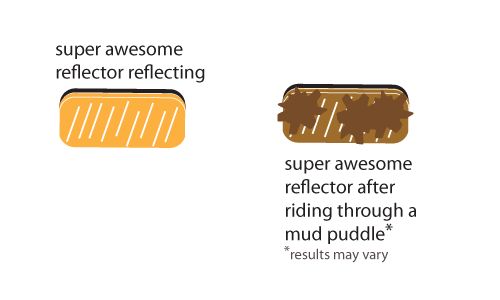A transportation nerd will tell you that creating conditions for safe travel requires appropriate, maintained infrastructure, safe behaviors by all parties using that infrastructure (culturally ingrained and legally enacted), and appropriate use of safety enhancing equipment.
When bad things happen to cyclists, most people will ask about a few of these objects of safety. Did he have lights? Was she wearing a helmet?
People who care about everyday cyclists and cycling issues ask about the infrastructure and behaviors surrounding the crash so that they might be able to take that information and make the infrastructure better or make more people aware of the behaviors that led to a cyclist getting hurt or killed and made a family cry more than they should have to.
And these are big issues that make all kinds of people angry because someone isn’t taking the issue seriously enough, and somebody else doesn’t understand how that parking space is really a necessity, or that we truly need tractor trailers on narrow streets or whatever these things are that people care about this time. And then these conversations seem to pause and begin to move at the time scale of infrastructure, legal, and cultural change – slow, incremental, long quiet periods with short bursts of action.
Changing the big stuff is hard, but I can buy a new light or stick a shinier helmet on my head or buy an obscenely expensive object that claims to enhance my safety.
People keep focusing on objects of safety because they are small, and often pretty, and they are something that an individual can control We can kickstarter a louder bicycle light, for whatever that’s worth. We probably can’t kickstarter 10 more miles of cycletrack or to actually complete the Mass Ave project (I promise to donate $5 if someone does manage to do this).
We rely heavily on these objects to do their job. I trust that my brakes will continue to function, and I put on a helmet just in case my tires slip on some slush. Every evening, I count on some tiny LEDs and conspicuous bits of reflective plastic to keep tired, distracted people in multi-ton steel contraptions from accidentally running over me and thirty pounds worth of bicycle while I patiently wait to turn left across two lanes of Mass Ave traffic onto the neighborhood street that takes me home.
While driving my bicycle home, I see examples of people who adopt these objects of safety but haven’t consciously thought about the job these objects are supposed to do.
There’s some evidence that people who take efforts to make themselves visible over estimate their visibility to drivers. This doesn’t mean that people shouldn’t try to be visible, but all of these measures – the reflectors, the lights, the high-vis material – work together to put together a picture that a human being with friends and family and hopes and dreams is on the road trying to go somewhere, just like everyone else. There are effective and less effective ways to do this.
Not all of these objects are equal. I don’t think a $100 bow tie with retroreflective threads is any more safe than a $10 pair of reflective/high-vis combo ankle bands (in fact, the ankle bands might be more usefully visible).

Here, the minuteman guy has graciously demonstrated in my place: but as a short person with jackets of varying length, I can’t reliably use a seat post light, as my jacket or whatever is on my rear rack will likely obscure it. I use lights attached to my rear rack, helmet, or bag, depending on what makes the most sense or is actually in use.
Reflectors, including any kind of retroreflective fabric or tape, are only helpful when positioned such that direct light that is brighter than the ambient light conditions will hit them. They also need to cover a large enough area to be distinguishable from visual clutter at a useful distance. The vests worn by highway workers have 2-inch wide bands of retroreflective materials. A little bit of decorative retro-reflective jacket piping might be enough for someone in a driveway to see a sidewalk speed walker, but is it enough for someone travelling at 40 mph to see you in the road?

This goes for lights, too. This might be groundbreaking territory: mystery urban sludgeydust is somewhat opaque. Lights/Reflectors only work when they are mostly clean (I am talking to you, guy-with-eighty-dollar-reflective-walled-commuter-tires-who-hasn’t-washed-your-bike-in-six-months)
Fluorescent materials also need some actual light to be seen; they’re better during twilight and daytime than most other fabrics, but they don’t actually glow in the dark. Wearing a giant yellow anorak isn’t a panacea.
Traveling with a handful of these objects of safety might not be doing you any favors, if they are giving you more confidence in your visibility than they are contributing to helping other people see you. I can’t imagine that the girl I see at least once a week with no lights (but reflectors!) knows she is invisible, or that tall guy I see sometimes pass me on the way home knows that his tiny, road-mud-splattered, single-LED light is barely visible 25 feet back…
I don’t think you have to wear a safety vest or have 8000 lumens on-board or invest hundreds of dollars in lights to be visible to other drivers and pedestrians, but please do yourself a favor and figure out if the objects you bring to feel safe on the roads are actually helping you get from A to B in one piece.
Safe Travels. The winter is just getting started…
